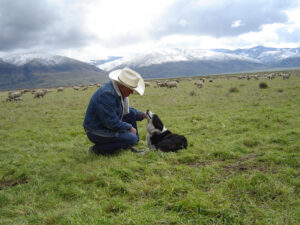Guard Dogs – The Sheep’s Best Friend
We all get excited when we see the sheep trailing through our valley. A band, typically 1,500 ewes and grown lambs, seems like a big responsibility for the lone sheepherder with his horse. But he has his helpers and constant companions.
The Border Collies, who in their black (or brown) and white coats, run back and forth and up and down the band, doing most of the work under the sheepherder’s directions. They keep the sheep moving, away from traffic or obstacles. Their tireless energy, willingness to not only work, but do so under command, draw our attention.
The other helpers may not appear visible. About the same size as a grown ewe, white in coat, with black eyes and nose, the Tantra Sheepdog, or the Great Pyrenees Mountain dog lumbers along so close, or within, the band he or she is hardly discernable. These 90-120 lb. dogs are not there to direct but to protect.
Wherever the sheep are, they can be victims of domestic dogs, wolves, other predators. It is the guard dogs who are alert to every sound and awaken 24/7 fully ready to give
their life to ensure the sheep are protected. They have been doing this for thousands of years. The now called ‘Great Pyrenees’ has a recorded history as a separate breed since 3000 B.C. in Asia. Since man began domesticating sheep, also in Asia, the Pyrenees has been not only working to guard the flock, but because of its nature to be part of a group, also became a friend and companion to the shepherd and family.
The dog moved westward across Europe and became a major partner with the Basque sheepherders. The breed was renamed in honor of their mountain range, the Pyrenees. When immigrating, the sheepherders brought their dogs along with their sheep. Meanwhile, on the other side of Europe, the Polish Tantra Mountain dog stayed in Eastern countries. Even as the two breeds look so similar, the Tantra is reported to have the mastiff in its hereditary lines.
Both look the same to the uneducated eye. Both do the job seriously. But whereas the Pyrenees will be more directly aggressive when guarding the band, the Tantra will often bark warnings first, seeking direction from the sheepherder on whether to attack or stay. As bands are constantly moving to forage in our mountains, and the growth of humans with domestic dogs sharing the same areas, Tantras have become preferable. Sometimes the two breeds are crossed.
Because most people don’t understand working dogs, they make assumptions that these animals should be treated as they would their own pets. But there is a union between sheepherder and rancher with these animals that goes beyond being a ‘pet.’ The sheepherder and rancher rely on these dogs to support their livelihood and are vital to their business operation. Of course, there is not a rancher or sheepherder who isn’t appreciative and endeared to these animals and a favorite may also become a ‘pet.’
It is also difficult to determine that these dogs are different than most domesticated breeds. They have kept many of their natural tendencies. They are more like wild dogs, coyotes, or wolves. They spend their whole lives outside. When these working dogs feel it is time to die, they will separate from the pack and wander. People often don’t understand and condemn the sheepherders and ranchers for this neglect. But it’s not neglect as the rancher or sheepherder knows as much about these dogs as their sheep. A good working dog is precious and not left behind lightly. Instead, there is respect and deep loss.
Life, death, and Mother Nature are faced daily in sheep ranching. This is not the vocation for the weak of stomach or disillusioned. At the same time there is more celebration in each life born, more appreciation for the life that is lost and greater appreciation for good weather, a sunrise, a sunset or a starry night. And the ranchers and sheepherders know this is all even better sharing with their canine partners.

